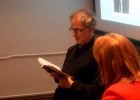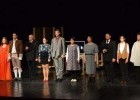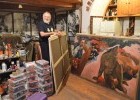The first book about Slovaks in Silbaš
 |
For Slovaks from Silbaš, this day was long expected since nearly all of them had the opportunity, back in 2012, to meet and discuss with at least one of the researchers from the Faculty of Philosophy UKF from Nitra about the cultural traditions of local Slovaks in the past and today.
Finally, when the preparations were about to be finished and when the Cultural Institute of Vojvodina’s Slovaks in cooperation with the printing house from Bački Petrovac published the book, everyone agreed that this unique monograph should be presented within the manifestation “The Charms of Cherry“, which was, for the 4th time, realized by the members of the Association of Women in Silbaš. Also, this was the reason why the designer Roman Zima “painted“ the book cover in burgundy and permanently added the symbolism of this event to the book.
 |
Besides the numerous residents, there were also guests in the Cultural Centre of Silbaš. Among these were the members of the women's associations from Lalić, Selenča, Stara Pazova, Kisač, Bački Petrovac and Rumenka who exhibited their handicraft and also brought along a variety of cherry sweets.
 |
The president of NCSNM and the vice president of APV Assembly Ana Tomanova Makanova, wished a successful course of events, and spoke about the significance of the activities of women's associations and the preservation of cultural traditions in Silbaš. She also talked about the monograph, which is important not only for the residents of this town, but for the entire Slovak community in Serbia, because it perpetuates and documents a way of life of Slovaks who live and have lived there continuously for more than two hundred years.
 |
The presentation was attended by a scientific research team consisting of: Jaroslav Čukan, Head of the Department of Managment and Culture of the Faculty of Philosophy UKF in Nitra, who is also the team leader, Ladislav Lenovski, Boris Mihaljik, Mihal Kurpaš and Roman Zima. During the program, hosted by Milina Sklabinski, the co-author of one of the texts in the book, the discussion was led about the concept of the book, the chapters on the methodology of data processing, what it includes and to what conclusion it brought us.
 |
Jaroslav Čukan pointed out the fact that, during the research which was conducted in Boljevci, Erdevik, Pivnice and the latest one in Silbaš, one could identify the same features, but it was always of bigger importance to find out something new and unique, that belongs only to that specific environment/place. In case of Silbaš we have highlighted the extraordinary ability of cultural mobilization – after the stagnation period, young people from Silbaš always manage to revive their minority’s culture and to bulid upon the cultural enlightenment of previous generations.
 |
L. Lenovski spoke about the colective identity, and in that way about the meaning of life and the customs which are cultivated within the family circles. B. Mihaljik spoke about the organized forms of cultural life and about the departure of the Slovaks from Silbaš abroad – to Europe and over seas. M. Kurpaš spoke of the characteristics of the local architecture, which he was studying during the preparation of this book.
Local authors also contributed to the realization of this publication, such as Jan Širka and evangelical priest from Silbaš, Vladimir Lovas, who helped gather documents and evidence that the first Slovaks lived in Silbaš even before 1799, and Milina Sklabinski who worked on analyzing Slovak folk songs from Silbaš. Although not present at the launch of the book, Marian Jarek, who wrote down the Slovak folk songs in Silbaš and Ivana Kontrik Šustekova, who dealt with the topic of Slovak cuisine and included in the book more than one recipe used in Silbaš, contributed to the content of the book.
 |
The book launch was also enriched by cultural-artistic program, which included musical, dance, and theatrical performances. The program featured the students of the Elementary School "Braća Novakov" from Silbaš, who were coached by Jarmila Križan and Miroslav Hložan, then the singing group of Women's Association Silbaš, amateur theatre groups APS, as well as the folk dancers and singers from Lug.
 |
The book launch was also an opportunity to publicly deliver copies of the publication to the authors of the individual chapters, and representatives of cultural and social life in Silbaš, such as the Principal of the school, "Jan Kolar" in Backi Petrovac, Paljo Beljička and the Director of NIU "Hlas ljudu," Samuel Žjak (both born in Silbaš), the President of the Local Community Danilo Pejak, the priest Vladimir Lovas, the Director of the Municipal Library in Backa Palanka Koviljka Dobric, the President ASUŽ Vjera Miškovic and others.
 |
The residents of Silbaš are now richer for a work of art which permanently documents their way of life. All of the relevant facts, which were treasured by the eldest residents of Silbaš and which to this day, testify about a Slovak island, which has endured away from the home state for more than two centuries, are presented on 450 pages of text and photos.
All interested in this topic can buy this book at the Cultural Institute of Vojvodina’s Slovaks, or at the Women‘s Association Silbaš for 400.00 dinars.
 |































